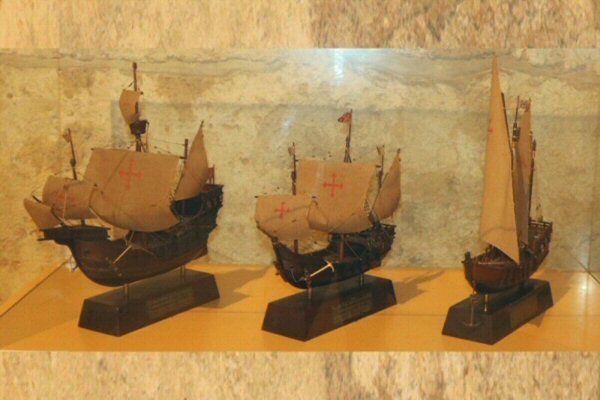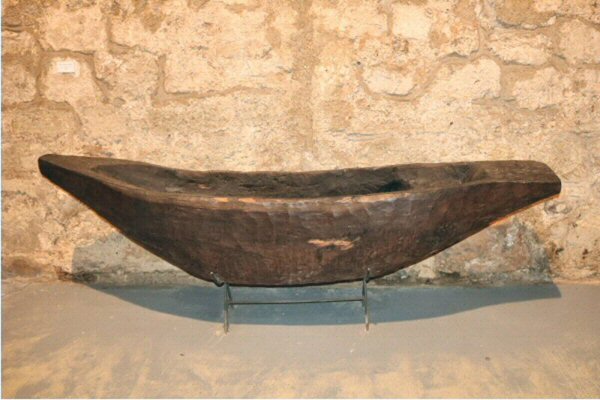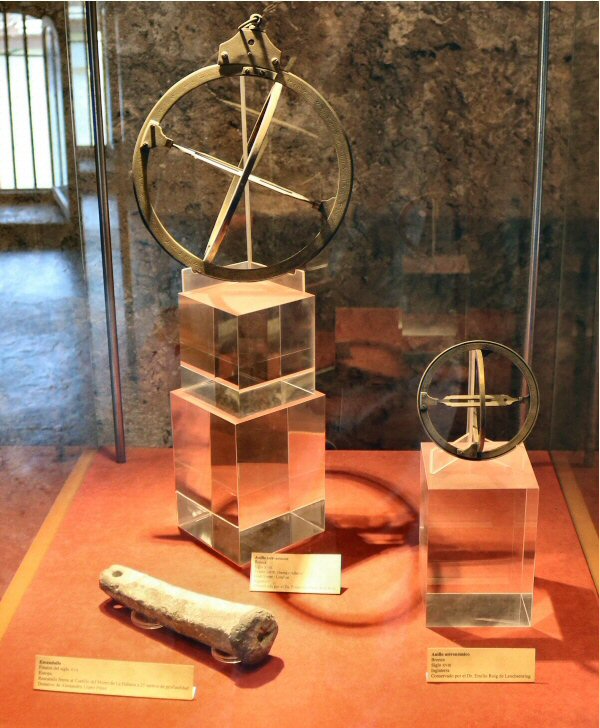
THE MUSEUM
The patio is rather small. The museum
has four exhibition rooms on the ground floor, in that
emphasis is
placed on the navigation around Cuba by models of
Spanish galleons, built in the period from the 15th century to
the 17th century. Along with the models of the well-known
galleons Santa María, La Pinta and La Niña that were used by
Christopher of Columbus in his first expedition to the island,
the models that were built in Cuba are
also exhibited in the
first exhibition room. Santa María was the largest of the three
vessels of Columbus.
In the same room there is also a canoe.
Similar one was used by the native Indians of some Caribbean
islands. The dimensions of the canoes varied according the
purpose and the size of the excavated tree. The body was
excavated by sea shells, then burned and the wood fibers were
crushed properly. The necessary information is given on the
labels on the walls; unfortunately, all are in Spanish.
In another exhibition room a detailed 1:
100 scale model of the Castillo de la Real Fuerza that bases on
a plan of the year 1691, is exhibited. On the model you can see
a big sentry box at the main entrance in front of the moat
through which you can enter into the castle. The model is ideal
to have an opinion about the whole architecture of the castle,
including the parts that can’t be reached by the visitors. In
the same room a good preserved arbalest and the helmet of a
Spanish soldier can be seen.


The third exhibition room is the most
spectacular one, as it contains the four meters long, 1:25 scale
model of the Santísima Trinidad, nicknamed El Escorial de los
Mares. It was the biggest and most powerful battleship in the
18th century, with a keel of 53 meters and a length of 60
meters. The crew was consisting of almost thousand sailors. It
was built in the shipyards of Havana in the period of 1767 and
1770. The chief architect was the Irish naval architect Matthew
Mullan. Interior construction details are shown on one side of
the vessel, and the visitors can take a virtual tour of the ship
on the touch screen in Spanish and English. It had four-gun
decks and was carrying 140 cannons. It was constructed from rare
Cuban woods like mahogany, jucaro and caguairan. After
participating in many battles, it had a tragic end as part of the combined
Franco-Spanish fleet
during the Battle of Trafalgar on October 21, 1805. Its great size and position immediately
ahead of the fleet flagship Bucentaure made it a target for the
British fleet.
In the same room, some disk or bar
shaped silver blocks that were found as flotsam northeast of Cayo Inés de Soto, an island at the north coast of Pinar del Rio
in Cuba, were exhibited in a showcase. It was the cargo of a
ship that had an accident on the way from Nueva España
to Havana in 1572.
In the other exhibition room, a lead (escandallo)
that was used to measure the depth of the sea, is
exhibited in a showcase. It belonged to the 17th century, and it was
found 25 meters under the sea surface in front of the Castillo
del Morro. In the same showcase two astronomical rings (anillos
astronómicos) of different size that were manufactured in
England, are exhibited. The astronomical ring is an old
instrument that was used as a sun dial to tell the time, when
the approximate latitude and season was known, or the latitude,
when the time was known. It consists of three rings, each
representing the celestial equator, declination, and the
meridian
In another showcase you will find three
different instruments (two sextants and one octant) that were
used in marine. The sextants were used to measure the angles
between two objects, such as two points at the coast or two
stars, but usually the sun and the horizon. The latitude could
be determined, if the time was known. The octant was used to
observe the height of the stars on the horizon of the sea.
On the upper level of the castle, there is a wide platform like a terrace and another exhibition room that displays the objects that were collected from the wrecks around the island, particularly at its northwest coast. You can receive enough information from the officer about each object that were retrieved from the sea bed, such as ceramics, original artifacts used on the boats, gold and silver coins etc.
The view from the roof over the eastern
part of the bay, especially at night, is amazing.

